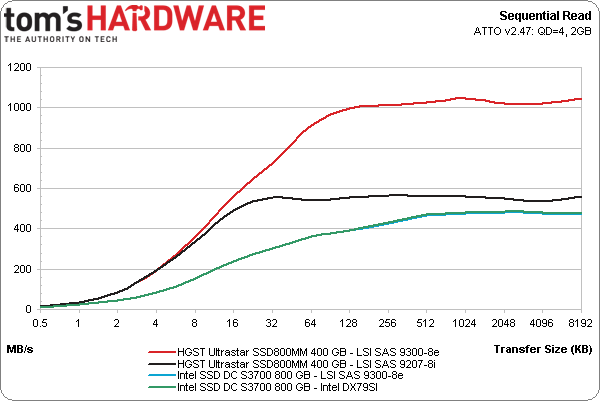LSI SAS 9300-8e & HGST Ultrastar SSD800MM: 12 Gb/s SAS, Tested
With the announcement of LSI's SAS 9300-8e and HGST's Ultrastar SSD800MM earlier this year, the world was officially introduced to 12 Gb/s SAS. Today we get our first look at how two times the interface bandwidth translates to real-world performance.
Results: Sequential Performance
Just like in our random small-block tests, the SSD800MM and SAS 9300-8e combination absolutely crush our sequential read and write tests.
Six-gigabit products can't come anywhere close to the SSD800MM and its 12 Gb/s SAS interface. Topping out at more than 1 GB/s is nothing short of impressive. Even limited to 6 Gb/s, we see that there was still room left to push higher throughput than Intel's drive achieves. And again, we observe minimal differences between LSI's SAS 9300-8e and X79's integrated controller.
Sequential writes are also outstanding compared to the competition at 6 Gb/s, though they're only about 50% higher (instead of the 100% that spoiled us in the read benchmark). Nevertheless, 735 MB/s is an admirable result. Constrained to a 6 Gb/s link, the SSD800MM still records a blistering 535 MB/s.
Get Tom's Hardware's best news and in-depth reviews, straight to your inbox.
Current page: Results: Sequential Performance
Prev Page Results: Enterprise Workload Performance Next Page Results: Enterprise Video Streaming Performance-
major-error The performance and relative maturity of this prototype drive certainly is impressive, but this is what the enterprise space demands.Reply
At the consumer level though, the article takes on a completely different tone--I would be very surprised if we don't start seeing mention of PCIe4 at/before the top of the next CPU cycle (so, in 24-36 months at most.) -
raidtarded Actually, Adaptec already saturated PCIe 3.0 with 6GB/s. The chart is incorrect, it doesn't take 12Gb/s to saturate the PCIe bus. Well, not for Adaptec.Reply -
falcompsx Remember when mechanical hard drives struggled to saturate their interfaces? Times sure have changed with SSD tech.Reply -
CaedenV Reply11006286 said:The performance and relative maturity of this prototype drive certainly is impressive, but this is what the enterprise space demands.
At the consumer level though, the article takes on a completely different tone--I would be very surprised if we don't start seeing mention of PCIe4 at/before the top of the next CPU cycle (so, in 24-36 months at most.)
Ya, my bet is that we will not start to see SATA4 or PCIe4 until Skymont at the earliest. Considering it is looking like Broadwell may be pushed back due to 14nm die shrink issues I would bet that Skymont will have similar issues when moving to 10nm. But at least for home users you can cram 2 SSDs in RAID0 with a proper RAID card and get a little performance boost until then. I guess the only problem is that most people are going to use the onboard Intel RAID for RAID0, which will get you a killer synthetic benchmark, but in practical reality it is really just expanding your volume with very little speed benefit. -
bit_user * wipes drool off floor *Reply
That's a quality review of some quality products. I like the insights shared, throughout. I especially appreciated the link to the SATA-Express paper. Thanks!
MORE REVIEWS LIKE THIS!!
:) -
bit_user Reply
How many ports and how many lanes, though? If it's just a 8-port card, the math doesn't support that, as 6x8 = 48 Gbps, which is less than the 8 x 8 = 64 Gbps that a x8 PCIe 3.0 slot should carry.11006482 said:Actually, Adaptec already saturated PCIe 3.0 with 6GB/s. The chart is incorrect, it doesn't take 12Gb/s to saturate the PCIe bus. Well, not for Adaptec.
-
raidtarded It is the equivalent of a nuke bomb compared to the LSI products. It has 24 Native ports.Reply11011736 said:
How many ports and how many lanes, though? If it's just a 8-port card, the math doesn't support that, as 6x8 = 48 Gbps, which is less than the 8 x 8 = 64 Gbps that a x8 PCIe 3.0 slot should carry.11006482 said:Actually, Adaptec already saturated PCIe 3.0 with 6GB/s. The chart is incorrect, it doesn't take 12Gb/s to saturate the PCIe bus. Well, not for Adaptec.

